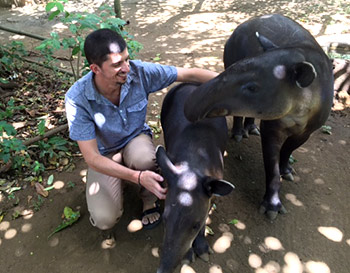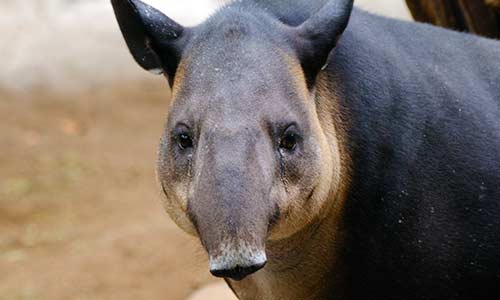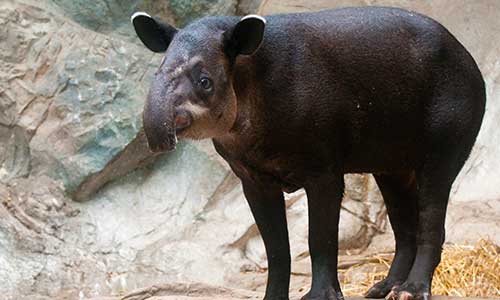From Massachusetts to Nicaragua – working on behalf of Baird’s tapirs
Thursday March 31, 2016
 Conservation is a cornerstone of Zoo New England’s mission, and the organization is deeply committed to supporting impactful conservation projects on behalf of wildlife and habitats both locally and abroad. This includes Proyecto Tapir Nicaragua, a program dedicated to protecting the globally endangered Baird’s tapirs and their habitat in Nicaragua. Headed by Massachusetts native Christopher Jordan, PhD, (pictured right) Proyecto Tapir Nicaragua combines research through radio collaring tapirs and reintroductions with local and national tapir conservation initiatives, as well as education initiatives to ensure a viable future for Baird’s tapirs in Nicaragua.
Conservation is a cornerstone of Zoo New England’s mission, and the organization is deeply committed to supporting impactful conservation projects on behalf of wildlife and habitats both locally and abroad. This includes Proyecto Tapir Nicaragua, a program dedicated to protecting the globally endangered Baird’s tapirs and their habitat in Nicaragua. Headed by Massachusetts native Christopher Jordan, PhD, (pictured right) Proyecto Tapir Nicaragua combines research through radio collaring tapirs and reintroductions with local and national tapir conservation initiatives, as well as education initiatives to ensure a viable future for Baird’s tapirs in Nicaragua.
“Although many may not yet realize it, the world’s zoos now play a critical role in saving our planet’s endangered flora and fauna,” said Jordan, a Leicester, Mass. native and the Nicaragua Programs director for Global Wildlife Conservation, a leading organization in endangered species and habitat conservation worldwide. “Our team has a unique relationship with Zoo New England. Not only have they directly helped us to advance our conservation and research efforts on the ground here in Nicaragua, but they have also worked with us to bring our global conservation messages to the public in Massachusetts and to show the impact that the state’s residents can have on saving the world’s imperiled species.”
Zoo New England provided funding to Jordan and his team through the Quarters for Conservation program at Zoo New England’s Franklin Park Zoo (Boston, Mass.) and Stone Zoo (Stoneham, Mass.). This creative program asks guests to use tokens to vote on the conservation project they would like the zoos to support. The Quarters for Conservation kiosks, which feature four different projects, are also an opportunity to educate visitors about some of the zoos’ conservation initiatives.
 With the funding from Zoo New England’s Quarters for Conservation program, Jordan and his team were able to successfully radio collar a wild female Baird’s tapir, which they named Katruk after a species of light red flower that grows along local rivers and creeks. The researchers have been monitoring Katruk’s movements throughout the past year. Her collar will be removed March 31 and the data gathered from this tracking device will help Jordan and his team better understand the resources that tapirs need to survive within the Indio-Maiz Biological Reserve, a forest area that is not only home to tapirs but is also home to many other threatened and endangered species.
With the funding from Zoo New England’s Quarters for Conservation program, Jordan and his team were able to successfully radio collar a wild female Baird’s tapir, which they named Katruk after a species of light red flower that grows along local rivers and creeks. The researchers have been monitoring Katruk’s movements throughout the past year. Her collar will be removed March 31 and the data gathered from this tracking device will help Jordan and his team better understand the resources that tapirs need to survive within the Indio-Maiz Biological Reserve, a forest area that is not only home to tapirs but is also home to many other threatened and endangered species.
“As an organization deeply committed to conservation, we are were especially pleased to support Proyecto Tapir Nicaragua and the important work being done in the field to better understand and protect Baird’s tapirs, as well as the impactful community outreach to foster a deeper understanding of wildlife and the important role we all play in ensuring healthy, thriving environments for all living creatures,” said John Linehan, Zoo New England President and CEO.
In addition to funding the radio collar for Katruk, the funding from Zoo New England also supported the illustration of a Spanish language children’s story on tapirs, which will be used in schools and as an educational tool in the communities where Proyecto Tapir Nicaragua works. Jordan has also given multiple lectures at Franklin Park Zoo, including participating in the zoo’s Science and Conservation Day in 2015.
 Weighing up to 600 pounds (273 kilos), Baird’s tapirs are the largest land mammal found in Central America and are considered endangered in the wild. While they are hunted for food and sport, their greatest threat to survival is habitat destruction due to logging and clearing of land for agriculture and development. Although jaguars may pose a threat to juvenile tapirs, humans are the only species that directly threatens the survival of tapirs in the wild.
Weighing up to 600 pounds (273 kilos), Baird’s tapirs are the largest land mammal found in Central America and are considered endangered in the wild. While they are hunted for food and sport, their greatest threat to survival is habitat destruction due to logging and clearing of land for agriculture and development. Although jaguars may pose a threat to juvenile tapirs, humans are the only species that directly threatens the survival of tapirs in the wild.
Jordan completed his undergraduate studies in Spanish and Latin American studies as well as wildlife conservation at the University of Massachusetts Amherst. He is also a member of the Steering Committee and the Nicaragua country coordinator for the IUCN Species Survival Commission Tapir Specialist Group. As GWC’s Nicaragua Programs Director, he developed and coordinates a forest ranger program with the indigenous people of Nicaragua’s southern Caribbean Coast and works to research and conserve Nicaragua’s Baird’s tapirs and jaguars.
For many years, Zoo New England has participated in the Baird’s Tapir Species Survival Plan (SSP), which is a cooperative, inter-zoo program coordinated nationally through the Association of Zoos and Aquariums (AZA). SSPs are designed to maintain a genetically diverse and demographically stable captive population. Franklin Park Zoo is home to two Baird’s tapirs – Milton and Abby, who have had several offspring and can be seen on exhibit inside the Tropical Forest building.
Learn more about tapirs in Franklin Park Zoo's Animals section.

